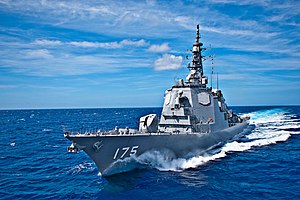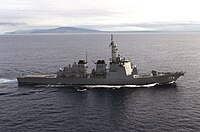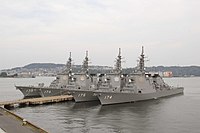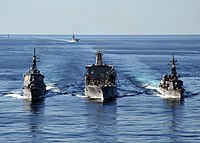 A port-front view of the JS Myōkō A port-front view of the JS Myōkō
| |
| Class overview | |
|---|---|
| Name | Kongō class |
| Builders | |
| Operators | |
| Preceded by | Hatakaze class |
| Succeeded by | Atago class |
| Built | 1990 - 1998 |
| Completed | 4 |
| Active | 4 |
| General characteristics | |
| Type | Guided-missile destroyer |
| Displacement |
|
| Length | 161 m (528 ft) |
| Beam | 21 m (69 ft) |
| Draft | 6.2 m (20 ft) |
| Propulsion |
|
| Speed | 30 knots (56 km/h; 35 mph) |
| Range | 4,500 nautical miles (8,300 km; 5,200 mi) at 20 knots (37 km/h; 23 mph) |
| Complement | 300 |
| Sensors and processing systems |
|
| Electronic warfare & decoys |
|
| Armament |
|
| Aircraft carried | 1 × SH-60J/K helicopter |
| Aviation facilities | Helicopter deck only |
The Kongō class (こんごう型護衛艦, Kongō-gata Goeikan) of guided-missile destroyers in the Japan Maritime Self-Defense Force are equipped with the Aegis Combat System, and is the first of few ship classes outside the United States to have that capability. Following a decision made in December 2003, Japan is upgrading their Kongo-class destroyers with Aegis Ballistic Missile Defense System. The upgrade involves a series of installations and flight tests to take place from 2007 to 2010. JS Kongo was the first ship to have the BMD upgrade installed.
Background
The JMSDF built JDS Amatsukaze (DDG-163) under FY1960 program and started shipboard operation of surface-to-air missiles. She had been equipped with analog-version of the Tartar Guided Missile Fire Control System. A fully-digitized system was adopted on the next-generation Tachikaze class, and later a combat direction system based on the Naval Tactical Data System was added.
Nevertheless, the JMSDF estimated that its fleets would not survive against Soviet airstrikes, especially Tupolev Tu-22M bombers using AS-4 air-to-surface missiles. Based on these estimates, JMSDF began to pursue the introduction of the Aegis Weapon System (AWS) from the early 1980s. In 1984, with the prospect of deploying AWS, concrete implementation plans began. And the construction of Japanese first Aegis-equipped ships, Kongo class, had begun under the FY1988 program.
Design
The overall design is generally modeled on the Arleigh Burke-class destroyers of the U.S. Navy. The hull adopted shelter deck design as with preceding Japanese destroyers, but it was widened to support the superstructure with four PESA antennas just as Arleigh Burke class. Due to this widened hull, the outer panel is inclined to reduce the width of the waterline, which also has the effect of reducing radar cross section area.
Because they are built to different operational requirements than the Arleigh Burke-class destroyers, such as for carrying extra commanding equipment, the Kongō-class ships' internal arrangement is quite different from the original design on which they are based. Recognisable external features are the vertical mast and enlarged superstructure to carry sufficient headquarters equipment so that they could act as a flagship.
The propulsion systems are almost the same as those of the Arleigh Burke class, powered by four Ishikawajima-Harima LM2500 gas turbines giving them a top speed of 30 knots (56 km/h; 35 mph).
-
 Starboard beam view of the JS Kirishima
Starboard beam view of the JS Kirishima
-
 All four Kongo-class destroyers at Sasebo
All four Kongo-class destroyers at Sasebo
-
 Kongō and Ikazuchi being refueled
Kongō and Ikazuchi being refueled
Equipment
The class is equipped with the Aegis Weapon System (AWS). The system version was Baseline 4 for name-ship through the third ship, and Baseline 5 for fourth ships immediately after they were put into service; then all ships were updated to Baseline 5.3 with modernization. The class uses the AN/SPY-1D as the main radar. As surface-to-air missiles, the SM-2MR Block IIIA was initially used, and later the Block IIIB came into use. Since the mid-2000s, they have also been equipped with a missile defense capability with the primary intention of countering North Korean ballistic missiles, and now have an Aegis BMD 3.6 system installed to launch SM-3 Block IA and IB missiles.
The Mark 41 Vertical Launching System arrangement, similar to the Arleigh Burke class, consisted of 29 cells on the foredeck and 61 cells on the afterdeck. These cells contain not only RIM-162, SM-2, and SM-3, but also VL-ASROCs. In addition, they are equipped with HOS-302, one of the Japanese variant of the Mark 32 Surface Vessel Torpedo Tubes, as anti-submarine weapons and Harpoon as anti-ship missiles. And as gunnery weapons, an Oto Melara 127 mm (5 in)/54 caliber gun and two Mark 15 20 mm CIWS gun mounts are installed.
Most of electronic devices outside of AWS originated in Japan. For electronic warfare, this class is equipped with NOLQ-2, an elaborate system capable of both ES and EA. The OQS-102 sonar is equivalent to the U.S. SQS-53C.
Flight tests for Aegis BMD systems
| This section does not cite any sources. Please help improve this section by adding citations to reliable sources. Unsourced material may be challenged and removed. Find sources: "Kongō-class destroyer" – news · newspapers · books · scholar · JSTOR (October 2024) (Learn how and when to remove this message) |
In December 2007, Japan conducted a successful test of the SM-3 block IA against a ballistic missile aboard Kongō. This was the first time a Japanese ship was selected to launch the interceptor missile during a test of the Aegis Ballistic Missile Defense System. In previous tests, they provided tracking and communications. Afterward, Japan has also undertaken another two successful Ballistic Missile Defense tests aboard Myōkō in October 2009 and aboard Kirishima in October 2010, while one test aboard Chōkai in November 2008 failed to intercept the target.
Names
The Kongō-class destroyers are named after mountains in Japan, and all four also share their names with World War II-era Japanese warships. Kongō and Kirishima share their names with two ships of the Kongō-class battlecruiser, while the other two ships share their names with the heavy cruisers Myōkō and Chōkai.
Ships in the class
| Building no. | Pennant no. | Name | Laid down | Launched | Commissioned | Homeport |
|---|---|---|---|---|---|---|
| 2313 | DDG-173 | Kongō | 8 May 1990 | 26 September 1991 | 25 March 1993 | Sasebo |
| 2314 | DDG-174 | Kirishima | 7 April 1992 | 19 August 1993 | 16 March 1995 | Yokosuka |
| 2315 | DDG-175 | Myōkō | 8 April 1993 | 5 October 1994 | 14 March 1996 | Maizuru |
| 2316 | DDG-176 | Chōkai | 29 May 1995 | 27 August 1996 | 20 March 1998 | Sasebo |
See also
- Aegis Combat System
- List of naval ship classes in service
- List of active Japan Maritime Self-Defense Force ships
References
- ^ Ishī 2019.
- "Japan to add Tomahawk launch function to Aegis destroyer Chokai". The Japan Times. 1 September 2024. Retrieved 31 October 2024.
- "First successful Japanese test for the Aegis Ballistic Missile Defense System". Gizmag. Retrieved 1 June 2015.
- Kōda 2015, pp. 52–59.
- Kōda 2015, pp. 112–117.
- Yamazaki 2014.
- ^ Wertheim 2013, pp. 363–364.
- "Kongo class Destroyer DDG Japan Maritime Self Defense Force". www.seaforces.org. Retrieved 4 November 2022.
Bibliography
- Ishī, Kōyū (December 2019). "Overview of World's Aegis ships: Kongo-class". Ships of the World (in Japanese) (913). Kaijin-sha: 88–89. NAID 40022058771.
- Kaijin-sha, ed. (August 2014). "All types of JMSDF's Missile destroyers: Kongo-class". Ships of the World (802). Kaijin-sha: 90–93. NAID 40020136021.
- Kōda, Yōji (December 2015). "History of Domestic Built Destroyers of JMSDF". Ships of the World (in Japanese) (827). Kaijin-sha. NAID 40020655404.
- Wertheim, Eric (2013). The Naval Institute Guide to Combat Fleets of the World, 16th Edition. Naval Institute Press. ISBN 978-1591149545.
- Yamazaki, Makoto (October 2011). "Combat systems of modern Japanese destroyers". Ships of the World (in Japanese) (748). Kaijin-sha: 98–107. NAID 40018965310.
- Yamazaki, Makoto (August 2014). "Development of Japanese DDG". Ships of the World (802). Kaijin-sha: 69–75. NAID 40020135975.
External links
- GlobalSecurity.org; JMSDF DDG Kongo Class
- Japan Maritime Self-Defense Forces page on Andrew Toppan's Haze Gray and Underway web site
| Kongō-class destroyers | |
|---|---|
| |
| Combatant ship classes of the Japan Maritime Self-Defense Force | |
|---|---|
| Helicopter Destroyer (DDH) | |
| Guided Missile Destroyer (DDG) | |
| Destroyer (DD) | |
| All Purpose Destroyer (DDA) | |
| Anti Submarine Destroyer (DDK) | |
| Destroyer Escort (DE) | |
| Frigate Multi-Purpose/Mine (FFM) | |
| Patrol Frigate (PF) | |
| Submarine (SS) | |
| Ocean Minehunters/Minesweepers (MHS) | |
| Minesweeper Tenders (MST) | |
| Minelayers (MMC) | |
| Coastal Minehunters/Minesweepers (MHC/MSC) | |
| Amphibious Warfare (LST/LCU) | |
| Diving Support Vessel (YDT) | |
| Cable Laying Ship (ARC) | |
| Yacht (ASY) | |
| Research Ship (AGS/AOS) | |
| Replenishment Ship (AO/AOE) | |
| Patrol boat (PG) | |
| Submarine chaser (PC) | |
| Training ship (TV/ATS/TSS) | |
| Submarine rescue ship (ASR/AS) | |
| Experimental ship (ASE) | |
| Icebreaker (AGB) | |
| Mitsubishi Heavy Industries | |||||||||||||||
|---|---|---|---|---|---|---|---|---|---|---|---|---|---|---|---|
| Mitsubishi | |||||||||||||||
| Subsidiaries |  | ||||||||||||||
| Joint ventures |
| ||||||||||||||
| Products |
| ||||||||||||||
| People | |||||||||||||||
| Other | |||||||||||||||
| |||||||||||||||